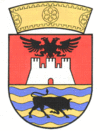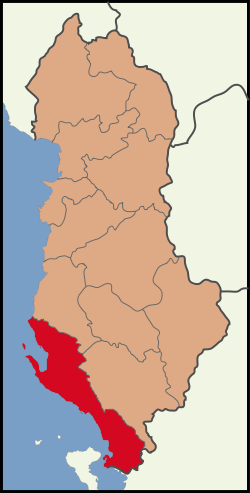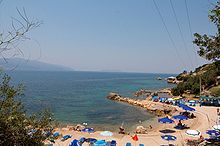- Vlorë County
-
Vlorë County
Qarku i Vlorës— County —
Coat of armsLocation of Vlorë County within Albania. Country  Albania
AlbaniaNumber of Districts 3 Capital Vlorë Area – Total 2,706 km2 (1,044.8 sq mi) Population (2010)[1] – Total 211,773 – Density 78.3/km2 (202.7/sq mi) Time zone CET (UTC+1) – Summer (DST) CEST (UTC+2) Website http://www.qarkuvlore.gov.al/ The County of Vlorë (Albanian: Qarku i Vlorës) is one of the 12 counties of Albania. It consists of the districts Delvinë, Sarandë and Vlorë and its capital is Vlorë.[2] As of January 1, 2010 the population of the Vlore District was estimated to be 211,773.[1] Vlorë's western and southern edges are the shorelines of the Strait of Otranto, which separates it from the island of Corfu. The County forms the integral part of the Albanian Riviera. In the far southeast it has a small border with Greece. Its population includes a Greek minority. Domestically, it borders the following counties Fier County to the north and Gjirokastër County to the east.
Contents
Names
The modern name for Vlorë is the Albanian form Vlorë or Vlora, pronounced [ˈvlɔɾə], while in the Gheg Albanian dialect it is known as Vlonë.[3] Vlorë was created in antiquity as a Greek colony in the territory of Illyria. Its first name, still used today in Greece, is Aulón (Greek: Αυλών), which means valley and may have been a reinterpretation of a pre-Greek name.[4] In early 20th century, Vlorë was referred to in English as Avlona or by the Italian name Valona.[5] During the Ottoman era, the Turkish name Avlonya was also used.[6]
History
In antiquity the region was inhabited by the Greek tribe of the Chaonians. The Ancient Greeks developed the town of Sarandë which they referred to as Onchesmos (or Anchiasmos)[7][8][9] Onchesmos flourished as the port of the Chaonian capital of Phoenice[10][11] (modern-day Finiq). Further north another Chaonian settlement was founded, Himarë,[12] while the Corinthians found the colony of Aulon at the bay of Vlorë. Additional ancient settlements in the region included Thronium, Amantia, Oricum.
In the Middle Ages, the region was part of the Byzantine Empire, while during the Slavic invasion there is evidence the Byzantine rule was maintained in the area.[13]
In 1204 the region became part of the Despotate of Epirus but returned to the Byzantine Empire. In 1335 Albanian tribes descended south and were in possession of the area between Berat and the bay of Vlore,[14] while in 1345 after the Serbian invasion an independent principality was formed in Vlorë.
In the middle of the 14th century the aristocratic Delvina family ruled Delvinë and in 1354, Mehmet Ali Pasha Delvina was testified as the owner of the castle and the city.
Geography
Vlorë County is located in the south of Albania and forms the Albanian Riviera. The southeastern part of the county borders Greece. The county has a total area of 2,706 km2 (1,044.8 sq mi). The three main cities are Vlorë, Sarandë and Delvinë.
Administrative divisions
District Capital District
Population (2010)[15]Area (km²) Municipalities Delvinë District Delvinë 10,810 348 Delvinë, Finiq, Mesopotam, Vergo Sarandë District Sarandë 35,201 749 Aliko, Dhivër, Konispol, Ksamil, Livadhja, Lukovë, Markat, Sarandë, Xarrë Vlorë District Vlorë 147,411 1,609 Armen, Brataj, Himarë, Horë-Vranisht, Kotë, Novoselë, Orikum, Qendër, Selenicë, Sevaster, Shushicë, Vllahinë, Vlorë Economy
The city of Vlorë remains a major seaport and commercial centre, with a significant fishing and industrial sector. The county produces petroleum, natural gas, bitumen and salt.
Vlorë County has grown in importance in agriculture with very large-scale planting of olive and fruit trees, and the city has become center of the food processing, oil and bitumen export industries. The county is mainly agricultural and pastoral, producing oats, maize, cotton, olive oil, cattle, sheep, skins, hides and butter. These commodities are exported.
Tourism has become a major industry in recent years, with many hotels, recreational centers, and vast beaches.
References
- ^ a b "POPULLSIA SIPAS PREFEKTURAVE, 2001-2010". Albanian Institute of Statistics. http://www.instat.gov.al/graphics/doc/tabelat/Treguesit%20Sociale/Popullsia/POP%202009/t4%20.xls. Retrieved 2010-09-09.
- ^ http://mondediplo.com/maps/albanianmdv1999 The Albanians, a scattered people by Philippe Rekacewicz, Le Monde diplomatique, January 1999
- ^ The New Encyclopaedia Britannica. Encyclopaedia Britannica. 1974. p. 479. ISBN 0852292902. http://books.google.com/books?id=1BMrAAAAMAAJ&q=Vlonë+Gheg&dq=Vlonë+Gheg.
- ^ ,google book reference: Placenames of the World: Origins and Meanings of the Names for 6,600 Countries, Cities, Territories, Natural Features, and Historic Sites By Adrian Room Published by McFarland, 2005 ISBN 9780786422487 433 pages
- ^ Encyclopaedia Britannica, 11th edition (1911), "Avlona" article.
- ^ Gawrych, G. W. (2006). The crescent and the eagle: Ottoman rule, Islam and the Albanians, 1874-1913. I.B.Tauris. p. 23. ISBN 9781845112875. Google Book Search. Retrieved on August 25, 2009.
- ^ Strabo, The Geography, Book VII, Chapter 7.5: "...these mountains one comes to Onchesmus, another harbor, opposite which lie the western extremities of Corcyraea."
- ^ Bowden, William. Epirus Vetus: The Archaeology of a Late Antique Province. London: Duckworth, 2003, ISBN 0715631160, p. 14. "Anchiasmos (Onchesmos)"
- ^ Hodges, Richard. Saranda - Ancient Onchesmos: A Short History and Guide. Butrint Foundation, 2007. ISBN 9994394363
- ^ Talbert, Richard J.A. and Bagnall, Roger S. Barrington Atlas of the Greek and Roman World, 2000, p. 815. "harbor, cape or town in Epirus between Onchesmos and Bouthroton."
- ^ Eidinow, Esther. Oracles, Curses, and Risk Among the Ancient Greeks. Oxford University Press, 2007. ISBN 0199277788 "Onchesmos was the principal port of Phoinike, the capital of Chaonia,..."
- ^ An Inventory of Archaic and Classical Poleis: An Investigation Conducted by The Copenhagen Polis Centre for the Danish National Research Foundation by Mogens Herman Hansen, 2005, page 340.
- ^ Winnifrith Tom. Shattered eagles, Balkan fragments. Duckworth, 1995, ISBN 9780715626351, p. 102
- ^ Nicholas Geoffrey Lemprière Hammond. Migrations and invasions in Greece and adjacent areas. Noyes Press, 1976, ISBN 9780815550471, p. 61 "By 1335 they were in possession also of the area between Berat and the Gulf of Valona"
- ^ "POPULLSIA SIPAS RRETHEVE, 2001–2010". Albanian Institute of Statistics. http://www.instat.gov.al/graphics/doc/tabelat/Treguesit%20Sociale/Popullsia/POP%202009/t2.xls. Retrieved 2010-09-09.
External links
Counties of Albania Municipalities of Vlorë County Capital: VlorëDelvinë District 
Sarandë District Vlorë District Albanian Riviera Cities Villages National Parks See also Categories:
Wikimedia Foundation. 2010.



